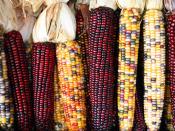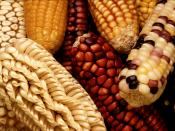This application claims the priority of U.S. Provisional Appl. Ser. No. 60/917,474, filed May 11, 2007, the entire disclosure of which is incorporated herein by reference.
BACKGROUND OF THE INVENTION1. Field of the InventionThe present invention relates generally to the field of corn breeding. In particular, the invention relates to corn seed and plants of the hybrid variety designated CH627005, and derivatives and tissue cultures thereof.
2. Description of Related ArtThe goal of field crop breeding is to combine various desirable traits in a single variety/hybrid. Such desirable traits include greater yield, better stalks, better roots, resistance to insecticides, herbicides, pests, and disease, tolerance to heat and drought, reduced time to crop maturity, better agronomic quality, higher nutritional value, and uniformity in germination times, stand establishment, growth rate, maturity, and fruit size.
Breeding techniques take advantage of a plant's method of pollination. There are two general methods of pollination: a plant self-pollinates if pollen from one flower is transferred to the same or another flower of the same plant.
A plant cross-pollinates if pollen comes to it from a flower on a different plant.
Corn plants ( Zea mays L.) can be bred by both self-pollination and cross-pollination. Both types of pollination involve the corn plant's flowers. Corn has separate male and female flowers on the same plant, located on the tassel and the ear, respectively. Natural pollination occurs in corn when wind blows pollen from the tassels to the silks that protrude from the tops of the ear shoot.
Plants that have been self-pollinated and selected for type over many generations become homozygous at almost all gene loci and produce a uniform population of true breeding progeny, a homozygous plant. A cross between two such homozygous plants produces a uniform population of hybrid plants that are heterozygous for many...


